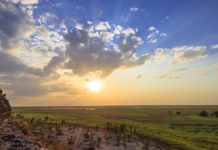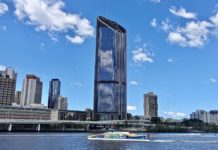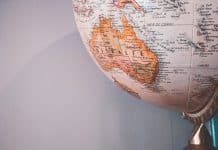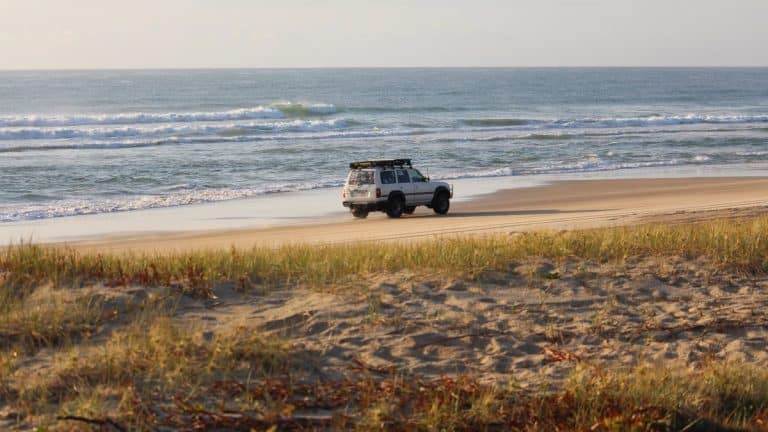
Fraser Island (K’gari) is a must-do for travellers. It is such an adventure, it is wild, beautiful, rich of landscapes and fauna. However, it is the kind of trip you need to prepare. First of all because there are some conditions to be adhered to on the island (permits, 4WD, etc), but also because there is not much there and it can be pretty dangerous to arrive in the wild without the necessary equipment. You could easily go from an amazing time to the worse holiday ever. You will find in this article all the necessary information to prepare your trip as well as some ideas to make up your itinerary once on the island.
Table of Contents
When to go to Fraser Island – Best season
Fraser Island is located more than 200 km north of Brisbane and enjoys a subtropical climate. The island enjoys fairly constant temperatures all year round, softened by its proximity to the sea. They vary from 23 to 30°C in summer (from September to April), and from 14 to 25°C in winter (from May to August).
If you visit the island in summer, you will be able to take advantage of the numerous water spots on the island. In the middle of summer, the average temperature is 29°C during the day and 22°C at night. However, you will have to deal with mosquitoes and a relatively high risk of rain.
Winter also has its advantages. Temperatures are always pleasant: on average 18°C during the day. So keep your shorts and flip-flops, but swap your t-shirt for a sweater. Also expect cool nights. Good news, winter is also the whale season! From July to November, you can watch humpback whales from the island or via an excursion.
If you have the opportunity, visit Fraser in the spring or fall, which are the best seasons to explore this incredible island.
How much time to do you need to explore Fraser Island?
The duration of your stay will all depend on your expectations. However, seeing the most famous places on the island means a lot of driving. We would recommend at least 2 nights on the island and 3 days exploring to make the best of your stay. Take your time, enjoy each place you go to and the feeling of wildness you will experience.
Saying that everybody is travelling differently and some people enjoy seeing a lot, very fast. In that case you can totally go for only 2 days. You will be on a tight schedule, but it is quite feasible if you don’t have more time. Some people even spend only one day there by joining a tour. Everything is possible depending on your means, expectations, and the time you have available.
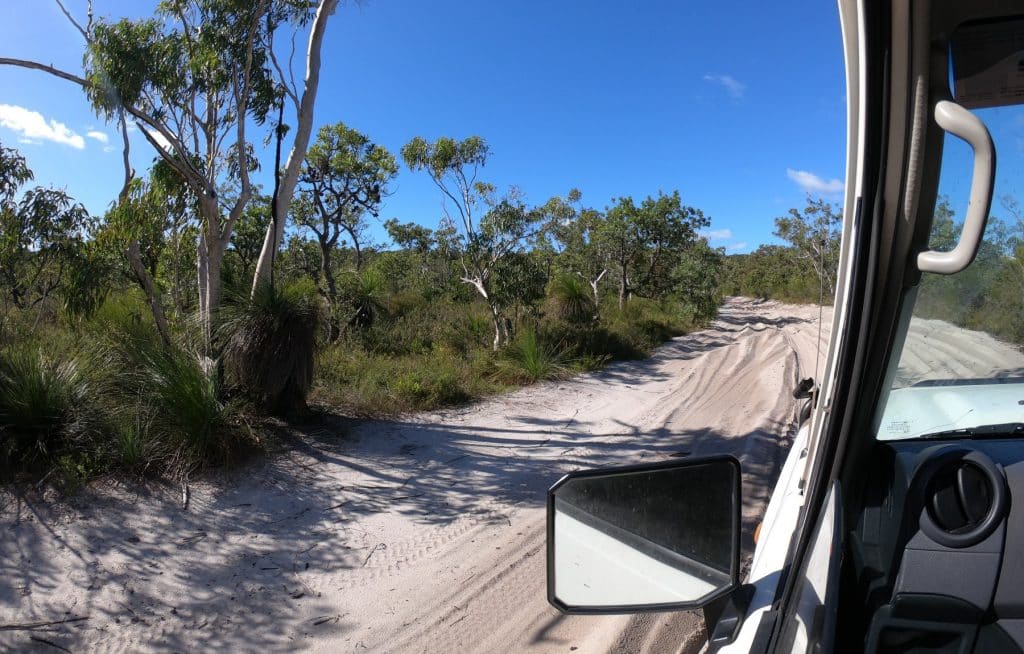
Fraser Island – Travel options
Tours & Excursions
If you don’t have a 4WD suitable for driving on sand, or if you prefer not to venture into this wilderness by yourself, you have the option of booking a tour.
You can choose a day trip, a 2 day trip or a more complete 3 day tour. Tours depart mainly from Rainbow Beach, Hervey Bay and Noosa. Prices vary depending on the length of your stay and the type of accommodation you choose (camping or hotel). Organized tours allow you to avoid the stress of organization. Fraser Island is more demanding than a traditional travel destination. Organized tours also allow you to be accompanied by a local guide who knows the island perfectly, the unmissable spots, the aboriginal history, etc. The island is full of activities, you will find your happiness!
Fraser Island Tours & Activities
Book your tour to Fraser Island. Find the perfect Tour or Activity and discover what makes Fraser Island a UNESCO World Heritage icon.
With your own vehicle
Those with a 4WD in good condition may consider traveling to Fraser Island on their own. However, you must plan your stay very precisely according to the tides, take note of the important phone numbers in case of problems and equip yourself in case you find yourself stuck in sand.
The tourist offices at Rainbow Beach and Hervey Bay collect photos of the accidents that took place on Fraser Island. So make sure not to end on their walls! You can buy your ferry tickets and the various permits required there (Pass as well as camping permit).
Great Option: If you’re planning to go on a road trip as soon as you arrive in Australia, a great option is to go through backpackercars.com. They offer all types of vehicles for sale (cars, vans, and 4WDs) and can customize them according to your needs. The advantage is that all the mechanics are checked, the paperwork is in order, and you can pick up your vehicle as soon as you arrive in Australia.
📍 Vehicles available in Sydney, Melbourne, and Perth
📝 Avoid all the paperwork
👨🔧 Avoid mechanical surprises with a reliable vehicle
🚗 Pick up your vehicle as soon as you arrive in Australia
🚨 BONUS: 1 year of free roadside assistance with our PROMO CODE: BACKPACKERS
Renting a 4WD
If you do not have a suitable vehicle, you can opt to rent a 4WD for your stay. Note, however, that some companies only rent their vehicles to people who are at least 25 years old. Also be aware that some roads on Fraser are prohibited by the rental companies. Check to see which roads you can take with the rental car. As with tour packages, prices vary depending on the length of stay and the vehicle rented. The prices are a little higher than for a classic rental (outside the island) and oscillate around 230$/day.
It is recommended to have a good level of English to understand the instructions of the renter, and to have some experience with driving a 4WD. As a reminder, there are no roads on Fraser. It is the biggest sand island in the world!
Finding a lift
A good option to explore Fraser Island could be to find a lift. There are many people looking for travel mates when they go to Fraser Island. It is indeed a bit pricey to go with your own 4WD or to rent one and it can be convenient to have a car full and share the costs. This option can be great to meet people without having to go on a tour with its “touristy’ side.
Travel by taxi
Another option for visiting the island is to take the taxi. Yes, there is a taxi company on Fraser Island called “Fraser Service”! This option will be interesting if you plan to do little trips on the island. Try to group all of your activities on a day and in the same area to limit your trips to a minimum. If you are considering this option, make sure you make your bookings a few weeks in advance to ensure the availability of the taxi company.
On foot
You will first need to take a cab to Fraser. Discovering the island on foot can be an incredible experience. The Fraser Island Great Walk is almost 90 km long and takes an average of 8 days to complete. You will walk through eucalyptus forests, sand dunes and discover the incredible lakes of the island, notably Lake McKenzie. The departure is from Dilli Village. Remember to book campsites in advance. Always be aware of fire hazards on the island. Some sections of the walk may be closed if there is a risk.
There are also shorter walks for the less experienced, such as the Lake Wabby Walk. You can also reach Champagne Pools from Indian Head.
How to get to Fraser Island?
Reach the Fraser Coast
The island is separated from mainland Australia by the Great Sandy Strait. Since there is no bridge, visitors must therefore travel by sea or air
You can get to the Fraser Coast:
- By road: The Fraser Coast is situated 3 hours away from Brisbane along the Bruce Highway.
- By bus: You can get a bus from Cairns, Brisbane or the Sunshine Coast to the Fraser Coast. They operate daily.
- By rail: Queensland Rail operates regular services from Brisbane, Rockhampton and Cairns to Maryborough West.
- By air: You can get a flight directly to Hervey Bay. Indeed, Virgin Australia operates direct jet services from Sydney or Brisbane to the Fraser Coast (Hervey Bay Airport).
How to get on Fraser Island
Once on the Fraser Coast, there are two ways to get to the island:
By Air: The closest airport is Hervey Bay/Fraser Coast. From there, you can either take a ferry or charter a flight to the island.
By Sea: Depart from Rainbow Beach (Manta Ray Barges) from Inskip Point to Hook Point, with services running from 6 AM to 5:15 PM. The ferry journey lasts about 15 minutes. Low season fares start at $130 round-trip for a standard 4×4, which includes all passengers in the vehicle. Alternatively, you can take a ferry from Hervey Bay (Kingfisher Bay Ferry) either from Kingfisher Bay (first ferry at 6:45 AM) or from Wanggoolba Creek (first ferry at 9 AM), with a crossing time of 30 to 50 minutes. Advance booking is required. Low season rates begin at $210 round-trip per vehicle, rising to $250 during the peak season
Download Fraser Island Map: www.npsr.qld.gov.au/parks/fraser/pdf/fraser-island-map.pdf
🌊 Before arriving on Fraser Island – Check the tide 🌊
It is difficult to plan a proper itinerary considering that your possibilities will depend on tides. It is something you really need to consider when going to Fraser Island because you need to plan your full trip around it. You don’t want to go up north and stay stuck there for hours because you didn’t realise the tide was coming in. There are a few difficult spots to go through on high tide. For instance, approximately half-way on 75-mile beach you will drive pass Eli Creek. It is the most critical part of the beach on high tide. The creek joins the sea and it gets really deep. Be extremely careful there and don’t try to cross or you might say goodbye to your 4WD.
What is the budget to discover Fraser?
Fraser Island is a destination that can be quite expensive. The way you discover the island and the time you spend there will inevitably vary your budget.
If you are traveling with your own vehicle
Beyond the cost of the ferry ($200 or so) and permits to travel on the island ($50) and to camp ($7.25/night), your expenses on the island will be less. Of course, you can also choose to stay in a hotel ($130/night minimum), but the camping option remains the most economical. As far as food is concerned, you should plan to buy some before leaving for the island so that you don’t have to spend money on the spot. If you have to buy on the spot, you will have to go to Eurong for example where prices are high. If you want to have dinner or lunch in a restaurant, count on about $50 per person.
You will have to fill up your car once on the island ($2/L minimum). And add a car cleaning after your escapade on the island (about 30$).
If you join a tour / excursion
You can choose between a day tour or a multi-day tour. For a day trip to Fraser, you can expect to pay around $250.
The best option is a 3-day tour, which offers you to discover all the major tourist sites of the island, includes nights in camping, transportation in 4WD and meals. For a tour of this duration, expect to pay about $500 per person (all inclusive).
Keep in mind that these rates are indicative and may vary depending on the season, available promotions, and specific choices you make during your visit to Fraser Island. It is wise to plan your budget accordingly and to make reservations in advance to secure the best possible rates.
The best spots on Fraser Island
75 mile beach
75 mile beach is situated on the East coast of Fraser Island, you can drive all the way up North and look for whales jumping from the view on the side. You will drive up to Champagne pools, pass Maheno wreck, Eli Creek, etc. It is a very nice drive and always such a pleasure to drive on the beach! A unique and adventurous experience. However, avoid swimming, currents are extremely dangerous and it is full of sharks!
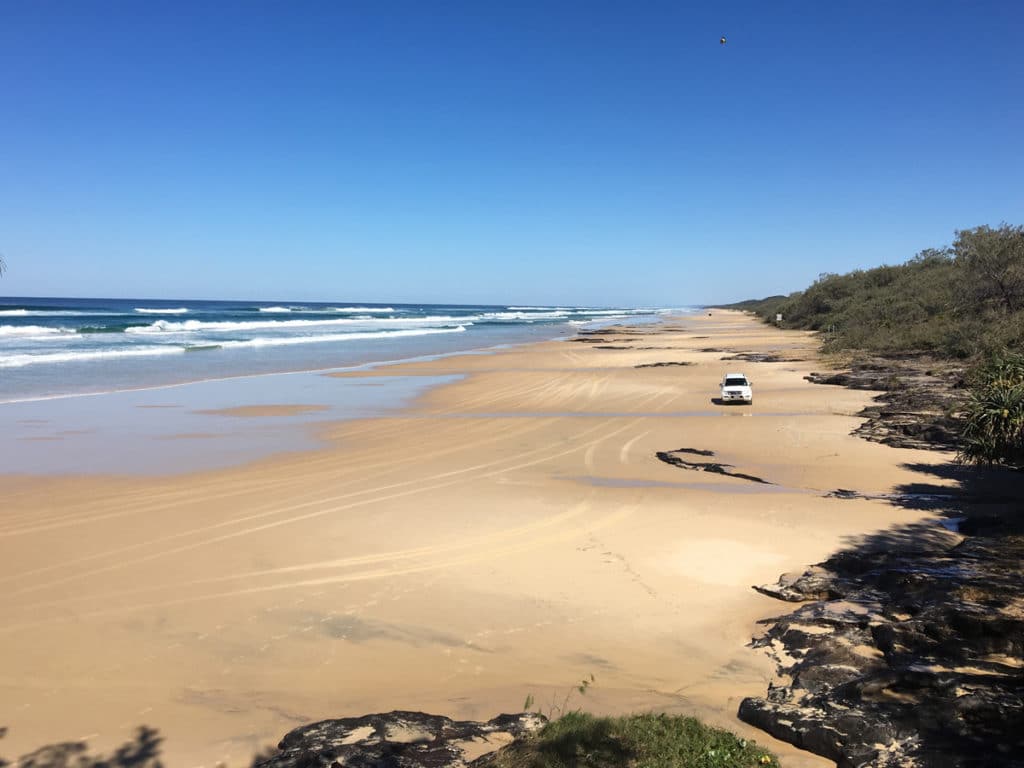
Maheno Wreck
The wreck was once a hospital ship used by the New Zealand naval forces during World War I. It ran aground on the shores of Fraser Island during a cyclone in 1935. You can observe its wreck, huge and completely exposed during low tides.
This shipwreck on the beach is a fascinating historical site to explore. It offers superb photography opportunities.
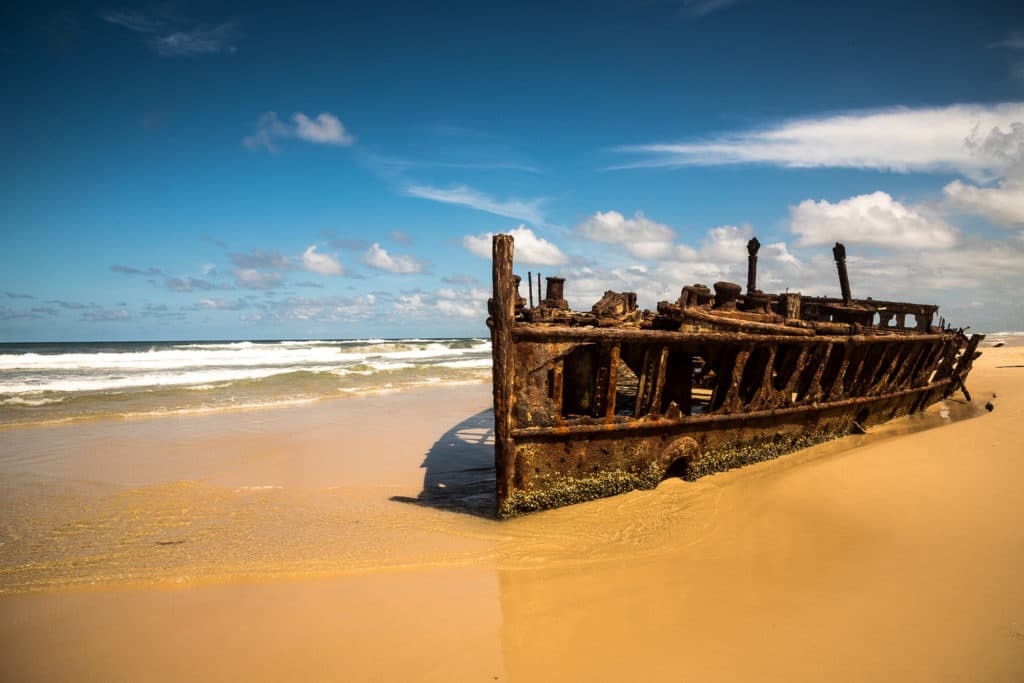
Champagne pools
Situated up North, Champagne pools is a pretty cool spot. The surf breaks and craches onto a wall of rocks arriving into a rock pool. It makes natural bubbling water, feels like a spa! The water is clear and it is a nice place to have a picnic or to spend an afternoon of leisure.
There are two possible routes to go there, by foot from Indian Head or by vehicle. To go there by 4WD you will need a high clearance one as it is very soft and the sand is deep. Don’t try it with a low clearance vehicle, you would not make it. You can walk there and enjoy the beautiful landscape. Allow a few hours.
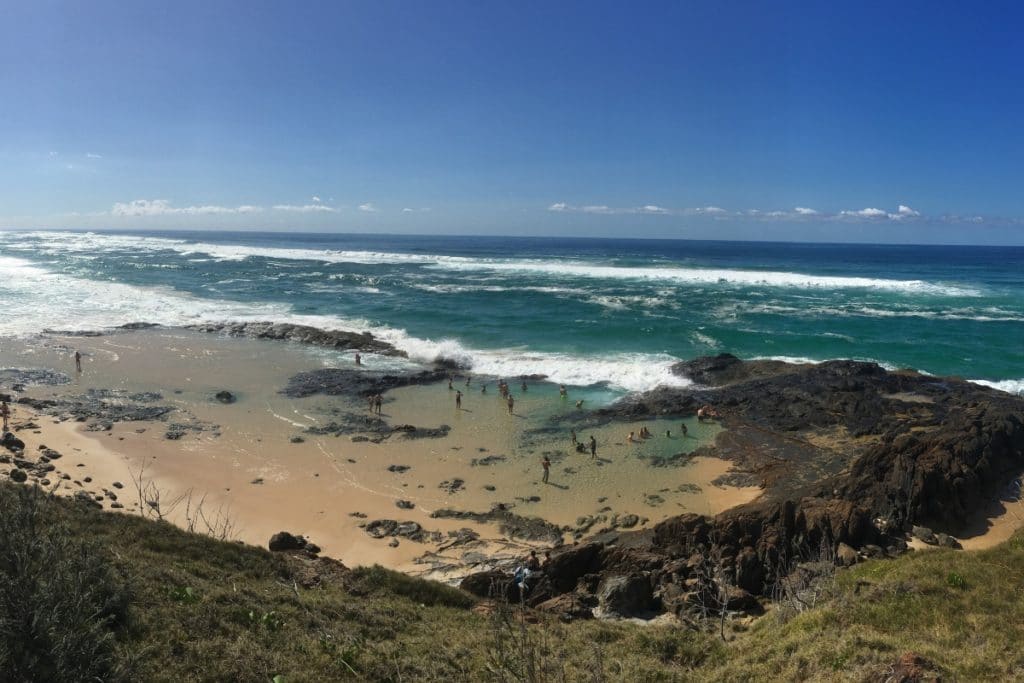
Indian Head
Captain Cook gave it its name in 1770, when Fraser Island was first discovered. The name would come from the aboriginal people he saw, Native populations were all considered as Indians at the time. It is located at one end of 75 mile beach and supposedly the best point of view of the island. You can see whales (during the right season), dolphins, sharks, turtles, etc. from there. It is also the starting point for the walk up to Champagne Pools.

Lake McKenzie
Lake McKenzie is a perched lake, which means it is only fed by rainwater whereas other lakes are usually fed by streams and flow to the ocean. The water is extremely clear and the sand extra thin. It is also slightly acid which limits the number of species living in the lake. Ideally, visitors should avoid wearing sunscreen, mosquito repellent, etc because it is polluting the extremely pure water. An absolutely beautiful and unique spot, it is perfect for a picnic (Be dingo safe, stay in the fenced area). There are also toilets facilities at the entry.
Driving up to the lake McKenzie is pretty rough. It isn’t far from the beach, only 25/30 kilometres. However, it is going to take you easily 3 hours return. You can only drive at 20 kilometres/hour as you are driving on a sandy and rocky track.
Important: Avoid applying sunscreen or mosquito repellent before entering the lake. These can pollute its extremely pure water.
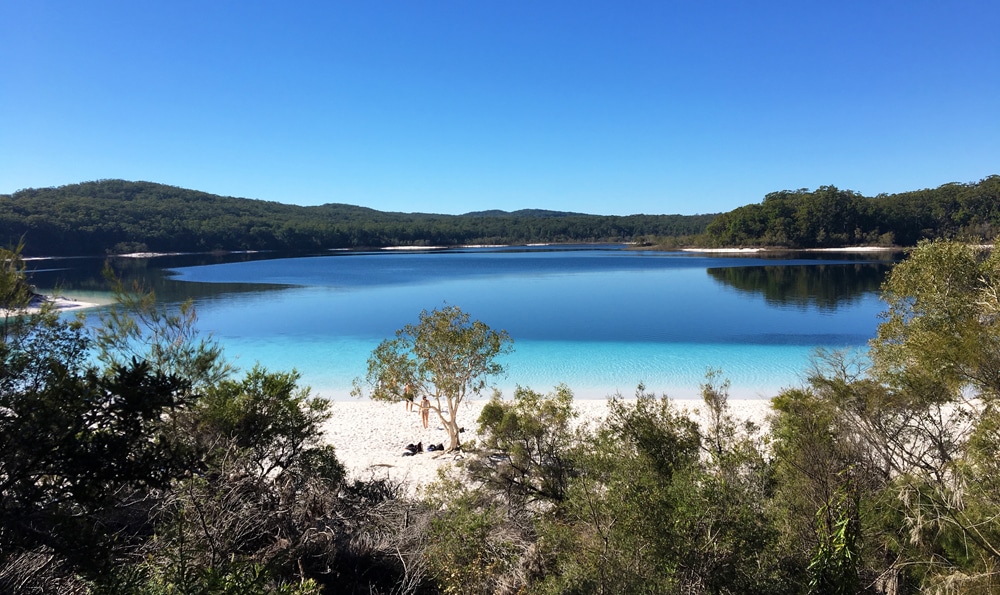
Eli Creek
Eli Creek is a freshwater creek going from inland to the beach. You can walk on its side along the boardwalk, jump in and float to the beach on your way back. The water is so clear and the landscape so wild and beautiful, you won’t regret the stop! Be careful when you drive through at high tide, it can get pretty deep. Stop for a while and enjoy the area while the tide lowers. There are toilets facilities there. Bring a floatable ring or a boogie board for more fun!
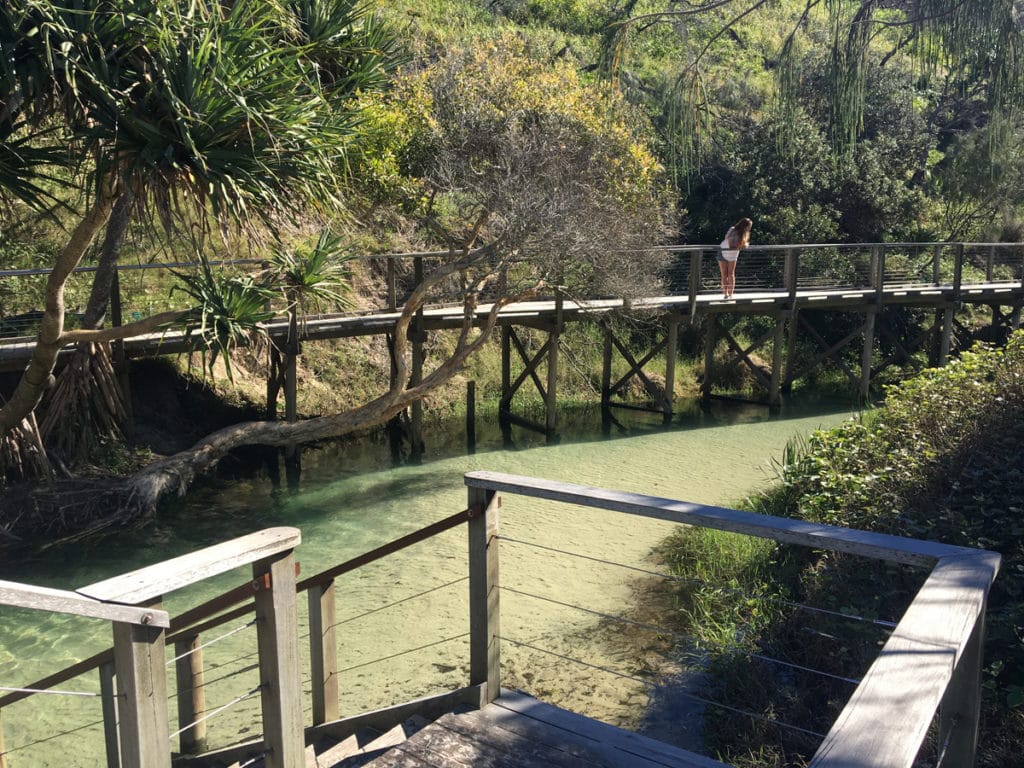
Pinnacles Coloured Sands
The Pinnacles are composed of coloured sand from iron compounds in the silica sand. They are made of numerous colours looking like a rainbow.
Lake Birrabeen
The lake is very similar to Lake McKenzie but not as touristic.You will find there the same clear water and white sand. It is much quieter so perfect if you prefer staying away from full buses of tourists.
Central Station & Wanggoolba Creek
Discover the history of timber exploitation on the island and take a walk along Wanggoolba Creek through a lush rainforest.
Wungul sandblow
Huge sand dune located behind the Dundubara camping ground. It is so big you will feel like being lost in the desert. A path allows direct access to the dune from the campsite.
Sandy Cape
Located at the northern tip of the island, Sandy Cape is the northernmost point of Fraser Island. This enchanting place is characterized by its majestic sand dunes and crystal-clear waters.
For camping enthusiasts, Sandy Cape offers opportunities for camping in the wild, where you can spend a night under the stars while listening to the gentle sound of the waves.
Wildlife on Fraser Island
Fraser Island (K’gari), known for its exceptional biodiversity, is home to a diverse and fascinating range of wildlife adapted to its unique sandy island environment. Among the most iconic inhabitants of the island are the pure dingoes, especially notable as they are considered the closest to their wild ancestors due to their isolation.
In addition to these wild canines, the island serves as a sanctuary for a multitude of birds, including white-bellied sea eagles and cockatoos, making it a paradise for bird watchers. The clear waters surrounding the island are populated by marine turtles, rays, and dolphins, which can be seen from the beach or during boat tours. The forests and scrub also house wallabies, echidnas, and a variety of reptiles.
Crocodiles have been spotted in the west as well as jellyfish dangerous to humans. Fraser Island is also known for its numerous sharks (great white, tiger shark, etc.).
The island is a prime spot for whale watching during the migration season (from June to October/November). You’ll see them leaping offshore, sometimes very close to the shore. You can also join a whale watching tour, close to the Fraser coast. Departures are usually from Hervey Bay and the tour lasts 4 hours.
Be careful with the dingoes. Never feed them or approach them. They are wild animals and they can be dangerous. Such behaviour is also illegal and the fines are very high.
Accommodation guide on Fraser Island
Camping
There are 45 camping areas options on Fraser Island. Each camping spot offers different facilities and amenities. They are situated all around the island. You will need to check a map and choose the spot the most adapted to your itinerary on Fraser Island.
Some camping areas are surrounded by a fence to be dingo safe. Which is recommended if you travel with kids for example and safer with food.
The price for a camping permit is $7.25/person/night. Book your campsite in advance as they can get quite busy. You can book on the Queensland Government website.
Hotels
If you are looking for the comfort of a hotel room, you can find your happiness on the island. There are about ten establishments that can accommodate you on the island. The rates will also vary according to the level of comfort you want. Fro some confort, Fraser offers options such as Kingfisher Bay Resort, Eurong Beach Resort, and holiday private renting.
Visit the island in a 4WD : useful info
Authorised Vehicles
The only type of vehicle allowed on the island is a 4WD. You will prefer a sufficiently high and powerful model. Indeed, a small 4WD will not be able to access all the places to see on the island. Fraser Island is a sandy island and people often get stuck in the sand. You absolutely want to be prepared for these situations.
Troubleshooting on the island is very expensive and can take hours. Wet sand is also very dangerous and getting stuck could mean saying goodbye to your SUV at rising tide. This is why you must remember to bring the necessary equipment such as a shovel, a spare tire, tools, etc.
Try not to drive in saltwater as it is very bad for your car. In addition, when you leave the island, it is best to rinse your vehicle with fresh water to prevent rust. You will find several specialised carwashes on the Fraser Coast.
Tides
Driving at low tide is highly recommended as driving becomes more complex and the chances of getting stuck in the sand are high during high tide. Avoid driving within 2 hours around high tide as some places will not be accessible.
Driving on Fraser Island
- Many people going to Fraser Island also drive the first time on the beach. It’s a great experience, but there are some basic rules to follow. The first thing to do is to lower the tire pressure. Then start slowly and don’t take any risks from the start. There are a huge number of small rivers going from land to sea. You don’t always see them but they can actually damage your car. It is much better to brake than to lose a wheel.
- You will need a permit to drive on the island, which costs $55.50 per vehicle. It must be displayed on your car windshield before boarding the ferry. You can get it online or at a tourist office counter on the Fraser Coast.
- Speed limits vary by area and are clearly marked. On the beach, the limit is generally 80 km/h, while in inland areas it is reduced to 30 km/h. These limits are in place for everyone’s safety and to protect wildlife.
- The beach is used both as a main road and as a landing strip for small planes. Stay vigilant, give priority to planes, and follow the instructions on signs and temporary markings.
- Respect the island’s natural environment by not littering, not picking plants or shells. Fraser Island is home to wild dingoes and other animals. Drive carefully to avoid injuring them and never feed them. Stick to designated hiking trails.
- When overtaking another vehicle, do so cautiously and at a moderate speed. Beaches can be narrow, so it is important to remain aware.
Petrol Stations on Fraser Island
There are 3 petrol stations on Fraser Island and they are very expensive. You really need to come to the island with a full tank, but also with cans if you can. Driving on the island consumes a lot and it is best to be prepared in case you get lost or find yourself too far from a petrol station.
Fraser Island / K’gari History
Fraser Island is the largest sand island in the world. It has a length of 123km and it is 22km wide. It is situated 300 km away from Brisbane and 15 km off the coast of Hervey Bay or Maryborough. Fraser Island was originally occupied by the Butchulla people, aboriginal meaning “The sea people”. In Butchulla people’s language Fraser Island was called K’gari meaning “Paradise”. Aboriginal legends are numerous and beautiful about the creation of the island.
Fraser Island was discovered for the first time in 1770, by James Cook. However it is only in 1836 that Captain Fraser, his wife and his crew sailed onto a reef. Many died, among them Captain Fraser, after he got captured by “Natives” with his wife. The name Fraser Island would be coming from Eliza Fraser. After weeks spent with the “Natives” she got rescued and went back to England. She told her story to everyone and from those stories the name Fraser Island became notorious.
Considering archaeological evidence, there have been signs of aboriginal life from 5000 years back.
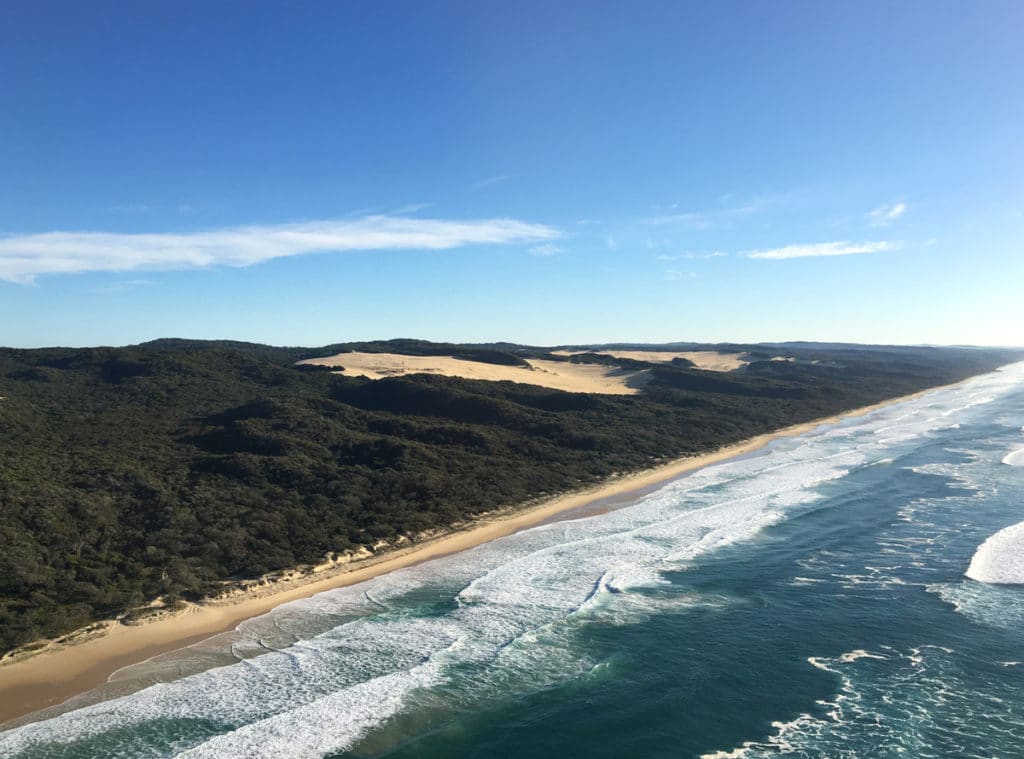
Practical information
Food
Toilets & Showers
You will need to check the Fraser Island map to get all the information about toilet facilities and choose the spot the most adapted for you. Be aware that showers aren’t free and you will need $2 coins to use them. They also only last for 3 minutes.
Phone network
The network coverage on the island is not very reliable, and many areas are not covered by any operator in Australia. You are warned.
Fires
Rubbish
What to take with you
- A lot of water it is getting really hot inland and get to the closest shop can take hours
- $2 coins if you want to have a shower
- 50cents and 20cents coins to use the public telephone (there is no service)
- Wood if you are going to use one of the fire pits (it is forbidden to pick up wood on the island)
- Some jerry cans of fuel, unless you want to pay $2.20/p/l on the island. You will need more than a full tank to get to all the spots to see on Fraser.
Frequently asked question about Fraser Island
Fraser Island beach is often described as “the most dangerous beach in the world”. It’s a popular meeting place for great white sharks, jellyfish and poison rays. What’s more, the currents are very strong and therefore very dangerous. In short, don’t swim in the ocean. You can, however, swim in the lakes, at Champagne Pool and Elie Creek.
Best spots are :
– Central Station Camping Area : Kauri Section
– Waddy Point (TOP) camping area
– Dundabara camping area.
All camping areas require advance reservations, especially during peak seasons, so consider booking online or contacting the regional offices by phone if you plan to visit Fraser Island.
The journey takes between 30 and 50 minutes from Hervey Bay and about 15 minutes from Rainbow Beach. You’ll need to arrive early to check in. Plan to arrive at least 30 minutes before boarding.




















